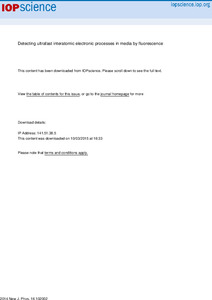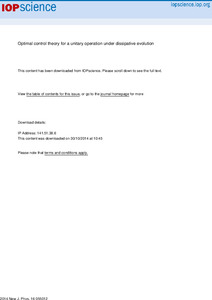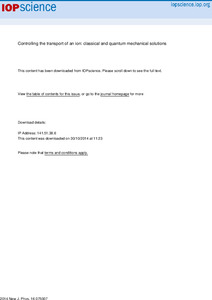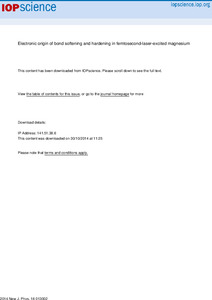Suche
Anzeige der Dokumente 1-4 von 4
Aufsatz
 Detecting ultrafast interatomic electronic processes in media by fluorescence
Detecting ultrafast interatomic electronic processes in media by fluorescence
(In: New journal of physics. - London : IOP, 2014, 16, 102002, 1-9, 2014)
Interatomic coulombic decay (ICD), a radiationless transition in weakly bonded systems, such as solutes or van der Waals bound aggregates, is an effective source for electrons of low kinetic energy. So far, the ICD processes could only be probed in ultra-high vacuum by using electron and/or ion spectroscopy. Here we show that resonant ICD processes can also be detected by measuring the subsequently emitted characteristic fluorescence radiation, which makes their study in dense media possible.
Aufsatz
 Optimal control theory for a unitary operation under dissipative evolution
Optimal control theory for a unitary operation under dissipative evolution
(2014)
We show that optimizing a quantum gate for an open quantum system requires the time evolution of only three states irrespective of the dimension of Hilbert space. This represents a significant reduction in computational resources compared to the complete basis of Liouville space that is commonly believed necessary for this task. The reduction is based on two observations: the target is not a general dynamical map but a unitary operation; and the time evolution of two properly chosen states is sufficient to distinguish ...
Aufsatz
 Controlling the transport of an ion: classical and quantum mechanical solutions
Controlling the transport of an ion: classical and quantum mechanical solutions
(IOP, 2014)
The accurate transport of an ion over macroscopic distances represents a challenging control problem due to the different length and time scales that enter and the experimental limitations on the controls that need to be accounted for. Here, we investigate the performance of different control techniques for ion transport in state-of-the-art segmented miniaturized ion traps. We employ numerical optimization of classical trajectories and quantum wavepacket propagation as well as analytical solutions derived from invariant ...
Aufsatz
 Electronic origin of bond softening and hardening in femtosecond-laser-excited magnesium
Electronic origin of bond softening and hardening in femtosecond-laser-excited magnesium
(IOP, 2014)
Many ultrafast structural phenomena in solids at high fluences are related to the hardening or softening of particular lattice vibrations at lower fluences. In this paper we relate femtosecond-laser-induced phonon frequency changes to changes in the electronic density of states, which need to be evaluated only in the electronic ground state, following phonon displacement patterns. We illustrate this relationship for a particular lattice vibration of magnesium, for which we—surprisingly—find that there is both softening ...




